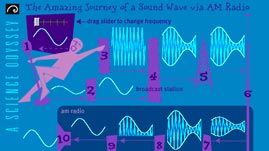In radio broadcast, as in most electronic sound transmission, the microphone and the loudspeaker are critical pieces of equipment because they provide the link between sound waves and radio waves. The microphone converts sound waves into electrical signals and the loudspeaker converts electrical signals back into sound waves.
Although microphones and loudspeakers serve opposite functions, they both rely on the close relationship between electricity and magnetism. An electrical current flowing through a wire creates a magnetic field around the wire. Magnetic fields from other sources, including fixed magnets and other wires with electrical current running through them, can exert force on a wire carrying a current just as they would on any other magnet.
In a microphone, the process of converting sound waves into electrical signals begins when sound waves, produced perhaps by the vibrations of a musical instrument or a person's vocal cords, cause a membrane to vibrate with the same frequency as the sound. This membrane, called a diaphragm, is connected to a wire coil, which is surrounded by the magnetic field of nearby magnets. When the diaphragm vibrates, so does the coil, and as the wire in the coil moves through the magnetic field, the magnetic field drives an electrical current along the wire. This current, or signal, has the same frequency as the sound that produced it, determined by the pitch of the sound, and its amplitude, or power, is proportional to the amplitude, or loudness, of the sound waves.
The loudspeaker works similarly to the microphone, but in reverse. The electrical signal from the radio's amplifier flows through a wire coil in the speaker. As it does, it creates a magnetic field that interacts with the magnetic field of a fixed magnet inside the speaker. This magnet and the paper or synthetic cone to which it is attached move in response to the changing fields created by the coil. As the cone vibrates back and forth, it pushes on the air in front of it and produces sound waves. These sound waves have the same frequency and proportional amplitude as the sound waves that created the original electrical impulses.


 Loading Standards
Loading Standards Teachers' Domain is proud to be a Pathways portal to the National Science Digital Library.
Teachers' Domain is proud to be a Pathways portal to the National Science Digital Library.
